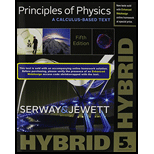
(a)
The number of components and the wavelength of each components.
(a)
Answer to Problem 56P
The numbers of components are
The wavelengths of each component are
Explanation of Solution
Write the expression for the separation distance.
Here,
Write the expression for the used wavelength.
Here,
Rewrite the expression (I) in terms of the number of components by using (II).
Rewrite the equation (I) in terms of wavelength.
Conclusion:
Substitute,
Hence, the number of components will be 1110100, 1110101, 1110102, 1110103 and so on.
For the first wavelength:
Substitute,
For the second wavelength:
Substitute,
For the third wavelength:
Substitute,
For the fourth wavelength:
Substitute,
Hence only first three wavelengths are possible.
Thus, the numbers of components are only three and the wavelengths of each components are
(b)
The root mean square speed for neon atom.
(b)
Answer to Problem 56P
The root mean square speed for neon atom is
Explanation of Solution
Write the expression for the root mean square speed by using conservation of energy.
Here,
Conclusion:
Substitute,
Thus, the root mean square speed for neon atom is
(c)
Whether the Doppler Effect for light emission by moving neon atoms should realistically make the bandwidth of the light amplifier larger than the 0.00140nm at
(c)
Answer to Problem 56P
The Doppler Effect for light emission by moving neon atoms should realistically make the bandwidth of the light amplifier larger than the 0.00140nm at
Explanation of Solution
Write the expression for the frequency from Doppler Effect.
Here,
Since, the frequency and the wavelength is inversely proportional, the apparent wavelength equation can be calculated by using equation (VI).
Write the expression for the apparent wavelength by using (II).
Here,
Conclusion:
Substitute,
The calculated wavelength is beyond limit. There will be many atoms which are moving more than rms speed. Hence, it can be expected that there will be more Doppler broadening of the resonance amplification peak.
Want to see more full solutions like this?
Chapter 24 Solutions
Principles of Physics: A Calculus-Based Text, Hybrid (with Enhanced WebAssign Printed Access Card)
- (a) For a spherical capacitor with inner radius a and outer radius b, we have the following for the capacitance. ab C = k₂(b- a) 0.0695 m 0.145 m (8.99 × 10º N · m²/c²)( [0.145 m- 0.0695 m × 10-11 F = PF IIarrow_forwardA pendulum bob A (0.5 kg) is given an initialspeed of vA = 4 m/s when the chord ishorizontal. It then hits a stationary block B (1kg) which then slides to a maximum distanced before it stops. Determine the value of d.The coefficient of static friction between theblock and the plane is μk = 0.2. The coefficientof restitution between A and B is e = 0.8.Ans: d=1.0034 marrow_forwardFigure 29-43 Problem 12. ••13 In Fig. 29-44, point P₁ is at distance R = 13.1 cm on the perpendicular bisector of a straight wire of length L = 18.0 cm carrying current i = 58.2 mA. (Note that the wire is not long.) What is the magnitude of the magnetic field at P₁ due to i? P2° R R Larrow_forward
- Checkpoint 1 The figure shows the current i in a single-loop circuit with a battery B and a resistance R (and wires of neg- ligible resistance). (a) Should the emf arrow at B be drawn pointing leftward or rightward? At points a, B C R b, and c, rank (b) the magnitude of the current, (c) the electric potential, and (d) the electric potential energy of the charge carriers, greatest first.arrow_forwardPls help ASAParrow_forwardPls help asaparrow_forward
- Pls help asaparrow_forward3. If the force of gravity stopped acting on the planets in our solar system, what would happen? a) They would spiral slowly towards the sun. b) They would continue in straight lines tangent to their orbits. c) They would continue to orbit the sun. d) They would fly straight away from the sun. e) They would spiral slowly away from the sun. 4. 1 The free-body diagram of a wagon being pulled along a horizontal surface is best represented by A F N B C 0 Ꭰ FN E a) A b) B c) C app app The app 10 app d) e) ס ח D E 10 apparrow_forwardPls help ASAParrow_forward

 Physics for Scientists and Engineers: Foundations...PhysicsISBN:9781133939146Author:Katz, Debora M.Publisher:Cengage Learning
Physics for Scientists and Engineers: Foundations...PhysicsISBN:9781133939146Author:Katz, Debora M.Publisher:Cengage Learning Principles of Physics: A Calculus-Based TextPhysicsISBN:9781133104261Author:Raymond A. Serway, John W. JewettPublisher:Cengage Learning
Principles of Physics: A Calculus-Based TextPhysicsISBN:9781133104261Author:Raymond A. Serway, John W. JewettPublisher:Cengage Learning Physics for Scientists and Engineers, Technology ...PhysicsISBN:9781305116399Author:Raymond A. Serway, John W. JewettPublisher:Cengage Learning
Physics for Scientists and Engineers, Technology ...PhysicsISBN:9781305116399Author:Raymond A. Serway, John W. JewettPublisher:Cengage Learning Physics for Scientists and EngineersPhysicsISBN:9781337553278Author:Raymond A. Serway, John W. JewettPublisher:Cengage Learning
Physics for Scientists and EngineersPhysicsISBN:9781337553278Author:Raymond A. Serway, John W. JewettPublisher:Cengage Learning Physics for Scientists and Engineers with Modern ...PhysicsISBN:9781337553292Author:Raymond A. Serway, John W. JewettPublisher:Cengage Learning
Physics for Scientists and Engineers with Modern ...PhysicsISBN:9781337553292Author:Raymond A. Serway, John W. JewettPublisher:Cengage Learning





